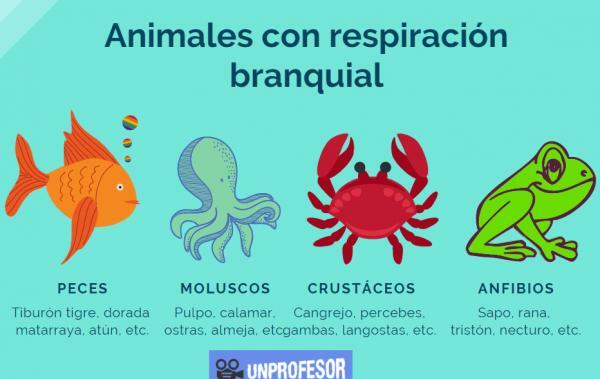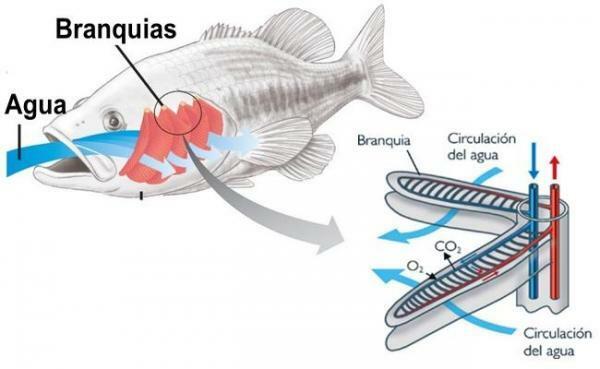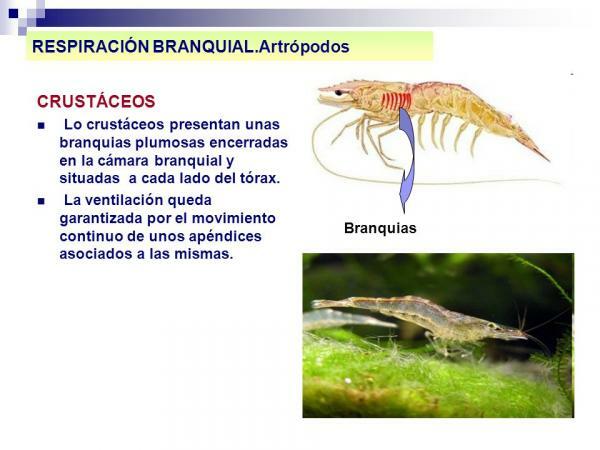ANIMALS with BRANCHIAL breathing: List + examples !!

Gill respiration is typical of animals that live the aquatic environment. Thanks to the gills, these animals can take the oxygen dissolved in the water and release the gases produced by respiration (mainly carbon dioxide).
But what are gill-breathing animals? If you start to think, you probably only remember fish, but there are many others gill breathing animals. In this lesson from a TEACHER we will explore to learn more about gill breathing animals, what types of gills they can have and many examples ranging from fish to crustaceans and even some worms!
Index
- The gills and the different types of gills
- Fish and gill respiration
- Gill-breathing mollusks
- Gill-breathing crustaceans
- Gill-breathing amphibians
- Annelids: gill-breathing worms
The gills and the different types of gills.
The gills are specialized bodies for respiration of organisms in water. The major difference between the lungs and the gills is that the gills are in contact with the external environment
While the lungs have structures that transport air into the body, without the need for them to be exposed.Even in animals with reinforced integuments, such as the scaly skin of fish or the coated body of crustaceans, the gills are always at least soft and fragile tissue covers with a large number of blood capillaries, which carry oxygen and carbon dioxide.
Types of gills
Within the gill-breathing animals there are two kinds of kinds of gills:
- External gills. They are primitive and simple structures that are found outside the animal's body, in direct contact with the environment. The gills are very soft, fine and capillary tissues, so they can be easily damaged; in addition, most of them have many projections and recesses, which make locomotion difficult.
- Internal gills. They are gills that occur in larger aquatic animals. These gills are partially sheltered in cavities or with cap-like structures; in both cases, the gills are more protected than in the previous case.

Image: Google Sites
Fish and gill respiration.
The vast majority of fishesThe ones you can think of have gill breathing. In fact, there are currently only six known species of lungfish and they are so rare that many of them do not even know the number of individuals that exist on the planet.
Also, most fish that we know of have internal gills:
- Tiger shark, Galeocerdo cuvier.
- Tintorera,Prionace glauca
- Seahorse, Hippocampus hippocampus
- White shark, Carcharodon carcharis.
- Golden, Sparus aurata
- Bull shark, Carcharis taurus.
- Clownfish, Amphiprion ocellaris
- Basking shark, Cetorhinus maximus.
- Common tuna, Thunnus thynnus
- Mackerel, Scomber scombrus
- Trout, Salmo trutta
- Common salmon, Salmo salar
- Corvina, Micropogonia undulatus
- Oceanic manta ray, Birostris blanket
The fish with external gills most representative is the axolotl (Ambystoma mexicanum).

Image: AnimalWised
Gill-breathing mollusks.
Others gill breathing animals are the mollusks. Here are 10 representative examples of mollusks with gills, but there are many more:
- Common or rock octopus, Octopus vulgaris.
- Common squid, Loligo vulgaris
- Portuano clam, Mya arenaria.
- Sea slugs or nudibranchs, Nudibranchi spp.
- Seashell, Phorcus lineatus
- Sea hare, Aplysia punctata
- Common oyster, Ostrea edulis
- Mussels, Mytilus galloprovincialis
- Coquina, Donax trunculus
- Nautilus, Nautilus pompilius

Image: Malacology
Crustaceans with gill respiration.
Although it does not come to our mind like the typical ones animals with gill respiration, crustaceans also present this type of respiration.
Virtually all crustaceans have gill respiration, but here we only introduce you 10 examples of animals with gill breathing, surely you can think of some more !:
- Common sea crab, Carcinus maenas
- Goose barnacles, Lepas anserifera.
- White prawn, Parapenaeus longirostris
- Crayfish, Nephrops norvegicus
- Hermit crab, Dardanus megistos
- California Red Lobster, Panulirus interruptus
- Moisture or freshwater mealybugs, Sphaeroma spp.
- Japanese crab, Macrocheira kaempferi
- Striated galatea, Galathea strigosa
- Yeti crab, Kiwa hirsuta

Image: Slideplayer
Amphibians with gill respiration.
most of amphibiansthey have pulmonary or cutaneous respiration, which they combine with gill respiration, especially in the larval stage. Some groups of amphibians, like some salamanders have gills throughout their lives, they are said to be evergreen.
The anuransOn the other hand, they only have gills when they are in the larval stage and, when they pass to their adult stage, they lose them. The same thing happens to caecilians that, although they do not have a larval phase, during their development they present gills that degenerate in one of the embryonic stages.
- Necturo, Necturus maculosus. Evergreen.
- South torrent salamander, Rhyacotriton variegatus
- Common salamander, Salamander salamander
- Lesser siren, Intermediate siren
- Amphibians, Amphiuma spp
- Italian crested newt, Triturus carnifex
- Idiocranium russeli
- Cecilia de Thompson, Caecilia thompsoni.
- European toad, Bufo bufo
- Common frog, Pelophylax perezi

Image: Slideshare
Annelids: gill-breathing worms.
One of the groups of gill-breathing animals is the annelids. Annelids are a group or phylum of animals, which collects many worm-like animals ranging from sea polychaetes to earthworms.
Here we point you out 6 examples of annelids that have gill respiration, some of them with a very apparent and showy external gills:
- Fire worm, Hermodice carunculata
- Marine worm, Arenicola marina
- Acholoe squamosa
- Spirograph,Sabella spallanzanii
- Giant tube worm, Riftia pachyptila
- Osedax rubiplumus
If you want to read more articles similar to Gill-breathing animals, we recommend that you enter our category of biology.
Bibliography
- Hill, R.W., Wyse, G.A. and Anderson, M. (2004) Animal Physiology. Editorial Panamericana S.A., Madrid.
- Moyes, C.D. and Schulte, P.M. (2006). Principles of Animal Physiology. Addison Wesley-Pearson. San Francisco.
- Encyclopedia of Examples (2019). Gill-breathing animals. Recovered from: https://www.ejemplos.co/animales-que-respiran-por-las-branquias/



